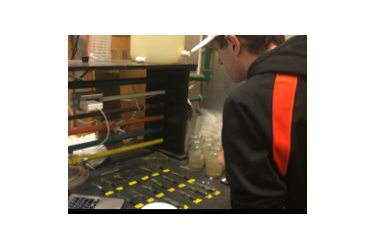U of I students design galactic greenhouse

URBANA, Ill. - Two University of Illinois engineering students have designed a miniature lunar greenhouse which they hope will enable humans to grow crops in lunar soil. They will present their design at the Lab2Moon Challenge in Bangalore, India in March. If they win the competition? Next stop – the moon.
Alex Darragh, a freshman in agricultural and biological engineering, and Matt Steinlauf, a freshman in mechanical engineering, won’t be traveling to the moon themselves, but their galactic greenhouse might.
The device is about the size of a beverage can and has an Archimedes screw that drills into the ground, lifts lunar soil (also called regolith) into the shell, and drops it into rotating cups. When the screw retracts, the hole closes and the device pressurizes and heats up. Tubes deposit seeds, water and fertilizer into the cups.
Darragh and Steinlauf will present their project to TeamIndus, an aerospace research organization sponsoring the Lab2Moon Challenge. TeamIndus is one of four privately owned companies traveling to the moon in December, hoping to win the Google Lunar XPrize, a global competition to challenge and inspire engineers and entrepreneurs to develop low-cost methods of robotic space exploration. To win the $30 million prize, a privately funded team must successfully place a robot on the moon, travel at least 500 meters, and transmit high-definition video and images back to earth.
To increase the opportunity for lunar research, TeamIndus challenged college students world-wide to design and build an experiment that would help develop sustainable life on the moon. There were more than 3,000 applicants from 15 countries and 300 cities.
Phase II of the competition narrowed the field to 25 teams. Darragh and Steinlauf’s team, Regolith Revolution, is one of three from the United States to make the cut. Several teams are from India, and Italy, Mexico, Peru, Spain, and the United Kingdom will also be represented. TeamIndus will manufacture the winning design and include it on their lunar voyage.
“Right now we’re conducting experiments in the lab and growing different plants in the lunar soil simulant,” said Darragh. “We’ve worked with Arabidopsis, the first plant that was grown in space. We’re also testing different fertilizer solutions to find the one that will work the best with lunar soils and plants and minimize the amount of nutrients you would have to bring to the moon.”
The team’s faculty mentors are Prasanta Kalita, a professor in agricultural and biological engineering and associate dean for academic programs in the College of Agricultural, Consumer and Environmental Sciences, and Sameh Tawfick, assistant professor in mechanical engineering in the College of Engineering.
Darragh says they are excited to be chosen as finalists in the competition, and regardless of the outcome, “It’s been an amazing experience to be part of a project that has so much potential.”
You can follow Regolith Revolution’s journey through video logs on their website at www.regolithrevolution.com.
-30-